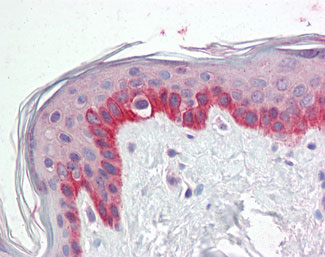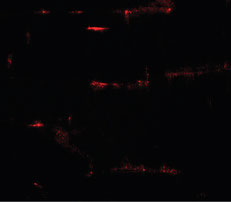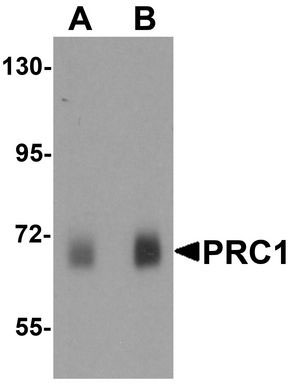PRC1 Antibody (Internal)
Rabbit Polyclonal Antibody
- SPECIFICATION
- CITATIONS
- PROTOCOLS
- BACKGROUND

Application
| WB, IHC-P, IF |
|---|---|
| Primary Accession | O43663 |
| Reactivity | Human, Mouse |
| Host | Rabbit |
| Clonality | Polyclonal |
| Calculated MW | 72kDa |
| Dilution | IHC-P (5 µg/ml), WB (0.5-1 µg/ml), |
| Gene ID | 9055 |
|---|---|
| Other Names | Protein regulator of cytokinesis 1, PRC1 {ECO:0000312|EMBL:AAC02688.1} |
| Target/Specificity | Human PRC1. At least three alternatively spliced transcript variants encoding distinct isoforms have been observed. |
| Reconstitution & Storage | Store at -20°C. Aliquot to avoid freeze/thaw cycles. |
| Precautions | PRC1 Antibody (Internal) is for research use only and not for use in diagnostic or therapeutic procedures. |
| Name | PRC1 (HGNC:9341) |
|---|---|
| Function | Key regulator of cytokinesis that cross-links antiparrallel microtubules at an average distance of 35 nM. Essential for controlling the spatiotemporal formation of the midzone and successful cytokinesis. Required for KIF14 localization to the central spindle and midbody. Required to recruit PLK1 to the spindle. Stimulates PLK1 phosphorylation of RACGAP1 to allow recruitment of ECT2 to the central spindle. Acts as an oncogene for promoting bladder cancer cells proliferation, apoptosis inhibition and carcinogenic progression (PubMed:17409436). |
| Cellular Location | Nucleus. Cytoplasm. Cytoplasm, cytoskeleton, spindle pole. Midbody. Chromosome. Note=Colocalized with KIF20B in the nucleus of bladder carcinoma cells at the interphase. Colocalized with KIF20B in bladder carcinoma cells at prophase, metaphase, early anaphase, at the midzone in late anaphase and at the contractile ring in telophase (PubMed:17409436). Predominantly localized to the nucleus of interphase cells. During mitosis becomes associated with the mitotic spindle poles and localizes with the cell midbody during cytokinesis Co-localizes with PRC1 in early mitosis and at the spindle midzone from anaphase B to telophase (PubMed:15297875, PubMed:15625105) |
| Tissue Location | Overexpressed in bladder cancer cells (PubMed:17409436). |

Thousands of laboratories across the world have published research that depended on the performance of antibodies from Abcepta to advance their research. Check out links to articles that cite our products in major peer-reviewed journals, organized by research category.
info@abcepta.com, and receive a free "I Love Antibodies" mug.
Provided below are standard protocols that you may find useful for product applications.
Background
Key regulator of cytokinesis that cross-links antiparrallel microtubules at an average distance of 35 nM. Essential for controlling the spatiotemporal formation of the midzone and successful cytokinesis. Required for KIF14 localization to the central spindle and midbody. Required to recruit PLK1 to the spindle. Stimulates PLK1 phosphorylation of RACGAP1 to allow recruitment of ECT2 to the central spindle.
References
Jiang W.,et al.Mol. Cell 2:877-885(1998).
Ota T.,et al.Nat. Genet. 36:40-45(2004).
Zody M.C.,et al.Nature 440:671-675(2006).
Bechtel S.,et al.BMC Genomics 8:399-399(2007).
Mollinari C.,et al.J. Cell Biol. 157:1175-1186(2002).
If you have used an Abcepta product and would like to share how it has performed, please click on the "Submit Review" button and provide the requested information. Our staff will examine and post your review and contact you if needed.
If you have any additional inquiries please email technical services at tech@abcepta.com.













 Foundational characteristics of cancer include proliferation, angiogenesis, migration, evasion of apoptosis, and cellular immortality. Find key markers for these cellular processes and antibodies to detect them.
Foundational characteristics of cancer include proliferation, angiogenesis, migration, evasion of apoptosis, and cellular immortality. Find key markers for these cellular processes and antibodies to detect them. The SUMOplot™ Analysis Program predicts and scores sumoylation sites in your protein. SUMOylation is a post-translational modification involved in various cellular processes, such as nuclear-cytosolic transport, transcriptional regulation, apoptosis, protein stability, response to stress, and progression through the cell cycle.
The SUMOplot™ Analysis Program predicts and scores sumoylation sites in your protein. SUMOylation is a post-translational modification involved in various cellular processes, such as nuclear-cytosolic transport, transcriptional regulation, apoptosis, protein stability, response to stress, and progression through the cell cycle. The Autophagy Receptor Motif Plotter predicts and scores autophagy receptor binding sites in your protein. Identifying proteins connected to this pathway is critical to understanding the role of autophagy in physiological as well as pathological processes such as development, differentiation, neurodegenerative diseases, stress, infection, and cancer.
The Autophagy Receptor Motif Plotter predicts and scores autophagy receptor binding sites in your protein. Identifying proteins connected to this pathway is critical to understanding the role of autophagy in physiological as well as pathological processes such as development, differentiation, neurodegenerative diseases, stress, infection, and cancer.




